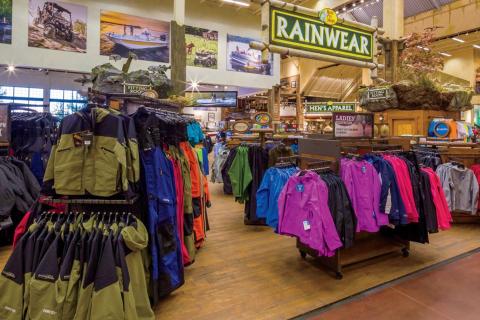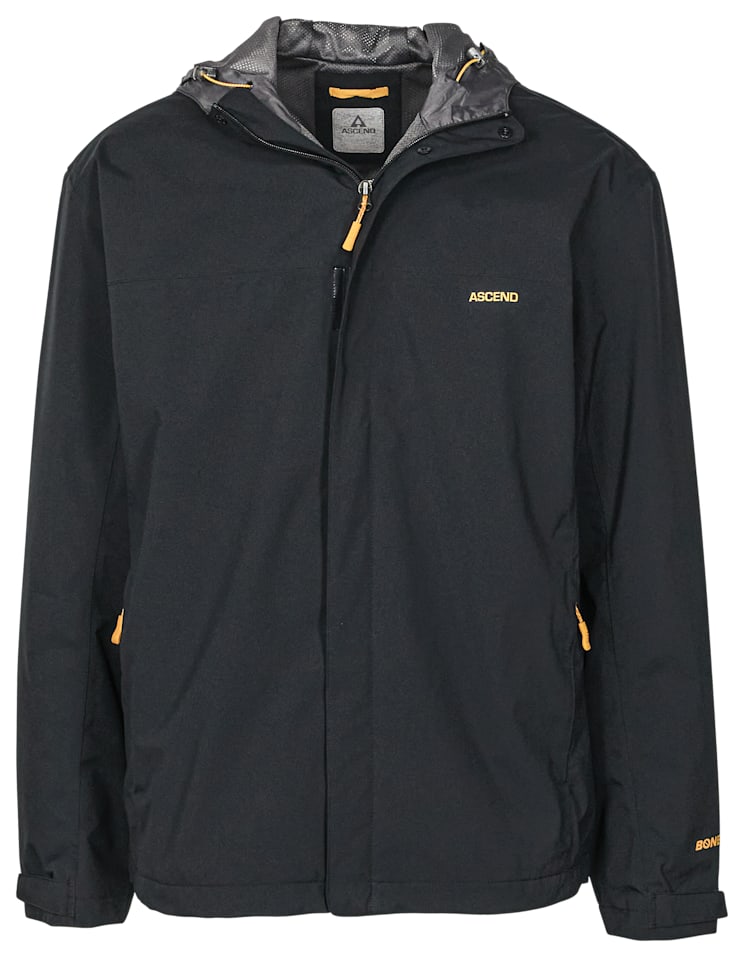
From the beginning, the challenge for rain gear manufacturers has been keeping the rain out without holding body heat in.

A search for the perfect solution to your rainwear needs should begin by selecting the right category and narrowing it down from there. In the broadest sense, rainwear can be separated into two basic categories: uninsulated and insulated. Both of these options can be found in jackets, pants, parkas and rain bibs like Bass Pro Shops Guidewear Pro Qualifier Jacket with BONE-DRY Gold.
Another critical issue in the selection process is determining what level of service you expect in terms of weather severity and duration. Rainwear that will keep you dry during a short jaunt from your car to a cabin doesn’t have to be that sturdy, and if you’re in a region where light rains blow through quickly, it becomes even less of an issue; however, if you have to be out all day in a real downpour for work, camping, hiking, fishing or hunting, you’ll need a more stalwart set of rain gear.
Methods of Rain Gear Protection & Treatment

Water Repellent
Rainwear is separated by the method of protection or treatment used, such as a membrane, laminate or PVC coating.
Rain Gear Membrane
Membranes are specially developed, breathable fabrics such as GORE-TEX and Cabela’s 4MOST DRY-PLUS, which are designed to keep moisture out while allowing body moisture to escape to reduce that clammy feeling. Other similar membranes are available under proprietary labels from other manufacturers.
Rain Gear Laminate Fabrics

Laminate fabrics are treated with a durable water-repellent (DWR) finish, and it’s actually the DWR coating that makes the rain bead up and slide off. The downside is that no DWR finish is permanent. With extended wear and many cycles through the laundry, the effectiveness fades; however, it is possible to use a spray-on product to restore the waterproof integrity. When the DWR coating has lost its effectiveness, the laminate will still keep you dry, but you feel clammy because the outer layer becomes damp. A regular care regimen will ensure that your rainwear lasts for many years.
Ideal for Fishing Rain Gear is PVC Coating
PVC stands for polyvinyl chloride, traditionally used for building materials. But when plasticizers are added, PVC becomes soft, pliable and impervious to water, ideal for work or fishing rainwear.
Rain Gear Should Have Taped & Sealed Seams

Rain gear with taped and sealed seams will be 100% waterproof. Garments that are waterproof, but do not have taped seams will work pretty well in light rain or heavy rain that doesn’t last long. However, when the rain is heavy over a period of time, water will eventually seep through the tiny holes that are created when stitching sleeves, pockets and hoods to the main body of a jacket or parka. To avoid the cold, clammy result of seam seepage, make sure the rainwear you buy has taped and sealed seams.
Rain Gear That is Not Insulated
Uninsulated rainwear is intended for warm climates, or the warmer months in cold climates, but it also can be worn over a layering system that offers the warmth you need in colder weather if you don’t mind the extra layer and bulk. Uninsulated rainwear can be found at several price points, depending on the features, fabric and durability.
Rain Gear That is Insulated
The option of insulation is one that falls into the category of personal preference. Some people need insulation on cool days and others don’t use it on even really cold days. For that reason, you will find most rainwear comes with the option of added insulation to give you the choice of both matching your body’s comfort level as well as your budget.
Rain Gear Styles
Parkas offer the most protection, combined with the best mobility. Jackets work well but are more restrictive in the chest area, compared with parkas. Rain pants are fine for most outdoor applications, like hiking, but if you’re involved in activities that produce wear, like sitting or kneeling, bibs will last longer and offer the best protection.
Specialty Rain Gear
Commercial-grade work rainwear: Lightweight PVC-coated rainwear is backed with nylon, but industrial-grade rainwear is made of PVC-coated, woven cotton twill or a polyester scrim. PVC-coated rainwear resists punctures and other hazards as well. Also, PVC-coated rainwear tends to be a little stiffer and heavier than other options, but in really foul weather it’s a fair trade. Rainwear of this type is typically used in rugged work environments such as that of an Alaskan commercial fisherman or construction worker.
Fishing rainwear: For fishing activities, the best option is a combination of parka and bibs or parka and pants. This gives you the flexibility to adapt to changing weather. Most fishing rainwear is ideal for wear right from the dock, even if it isn’t raining. And, it’s highly resistant to punctures and other hazards you encounter while on the water. When suited up, neither bow spray nor torrential downpours will keep you from fishing.

Hunting rainwear: When you consider the various elements of a day’s hunt, the need for silence, and scent containment, finding that perfect set of camo rainwear seems daunting.
Tip: Shop men's hunting rain gear here
Then there is the question of camo pattern, and for bowhunters, the need for manageable sleeves and a snag-free chest that won’t inhibit the draw or release. Hunting rainwear should not only excel at keeping the rain out, it should expel body heat and produce less than a whisper of noise during movement.
Specially designed stretchable fabrics make hunting gear less restrictive when coming to full draw or shouldering a rifle or shotgun, and these garments utilize soft, silent fabrics that won’t give away your position.
Most insulated big-game clothing is lined with tricot for its added warmth and moisture-wicking properties, but you also have a choice of mesh lining where heat is a factor.
When your method of hunting involves stalking and working close, scent containment is a must; however, for any big-game hunting tactics, keeping your scent from curious noses makes a lot of sense.
While you may find rainwear with a good price and the features you’re looking for, without a quiet outer material you run the risk of alerting approaching game with the rustle of fabric. Look for fabrics that have a low nap that won’t snag burs or collect moisture.
Now, the only thing you need to do is settle on the camo pattern you favor and get ready to hunt.
Once you’ve selected your casual, work, hunting or fishing rainwear, the next important thing is to take it with you. The last thing you want is to have to end your trip short because the weather forecast didn’t predict rain.
- 38835 views

